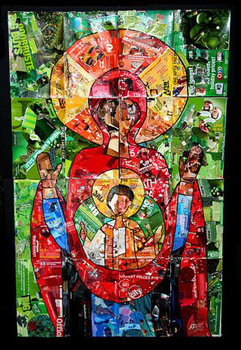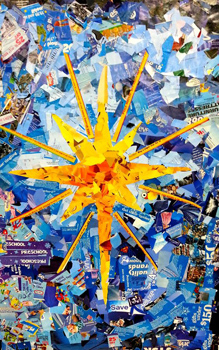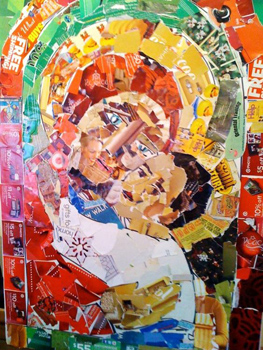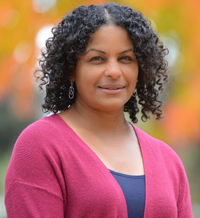For Sunday December 2, 2018
Lectionary Readings (Revised Common Lectionary, Year C)
Jeremiah 33:14-16
Psalm 25:1-10
1 Thessalonians 3:9-13
Luke 21:25-36
In his beautiful book of contemplation, In the Shelter, poet and theologian Pádraig Ó Tuama asks a question I’ve been thinking about for several weeks. “How do we say hello to here?” That is, how do we live honestly in our own skins? How do we accept what's in front of us? How do we guard against numbness, denial, and despair? In his opening chapter, Ó Tuama describes the challenge: “Much of our desire to not-name a place is because we fear that in naming it we are giving it power, and by giving it power we are saying we may not escape. It’s a valid fear. There are some suburbs of hell that we wish we’d never visited…. To name something can be to call it into being, and we do not wish to call certain things into any kind of being.”
In our Gospel reading for this first week of Advent, Jesus challenges us to name and welcome the “here,” even when the here is perilous. In prophetic language that sounds distressingly contemporary, Jesus describes a world reeling in pain. Roaring seas, distress among nations, people fainting in fear. “When you see these things,” Jesus says, don’t turn away. Don't hide. Why? Because it’s only when we embrace reality — when we acknowledge and welcome the “here” of human suffering — that we experience the nearness of God.
I didn't grow up observing Advent. My childhood church didn't follow the liturgical calendar, so the holiday lineup I remember went straight from Thanksgiving turkeys and pumpkin pies to Christmas trees and "Jingle Bells” — one consumer feeding frenzy pressing hard into the next. But as I’ve moved deeper into the liturgical tradition, I have come to love the holy season we’re now entering. I love that the Church begins its new year when the days are still getting darker. I love that the season rejects shallow sentimentality and false cheer. And I love that the Gospel gets us started this week with images — not of swaddling clothes, twinkly stars, and fleecy lambs — but of the world as it really is, here and now. Gorgeous, fragile, and falling apart.
 |
American novelist Flannery O’Connor once wrote, “To the hard of hearing you shout, and for the almost blind, you draw large and startling figures.” That’s precisely what Jesus does in his prophetic wake-up call. He shouts, he draws startling figures, and he uses every rhetorical device at his disposal to snap his listeners to attention. “Be on guard,” he warns his disciples. “Be alert.” “Stand up and raise your heads.” Look.
These aren’t the soothing, saccharine invitations we like to accept as we shop for gifts, decorate Christmas trees, and sing carols. But as Episcopal priest Fleming Rutledge reminds us, “Advent begins in the dark. It is not a season for the faint of heart.” Whether we like it or not, the invitations Advent offers us are hard-edged; they don’t look pretty on greeting cards. But they are essential and life-giving, neverthless. They help us say hello to here. They help us find redemption in the most startling places.
Here are some of the Advent invitations I’m reflecting on this week:
1. The invitation to tell the truth. Advent is a brutally candid season; it calls for honesty, even when honesty leads us straight to lamentation. In Advent, we are invited to describe life “on earth as it is," and not as we mistakenly assume our religion requires us to render it. We are invited to shout forth our pain and bewilderment. To name the seeming absence of God. To draw the large, startling figures of the apocalypse. Eschewing all forms of denial, polite piety, and cheap cheer, we are invited to allow the radical honesty of Scripture to make us honest, too. We’re asked to stop posturing and pretending. To come to the end of ourselves. To get real. Advent reminds us that we are not called to an escapist, denial-based piety. We are called to dwell courageously in the truth.
 |
2. The invitation to yearn. That is, to name the “here” of our desires without shame or reservation. Advent is the season when longing makes sense. When it’s okay to say we are hungry, thirsty, lonely, empty, unfinished, or unhoused. In Advent, we want, and we want fiercely. We sit in darkness, longing for light. We sit in exile, longing for home. We sit with aching, empty arms, waiting to cradle a life that’s still unformed, still hidden, still in process. In Advent, our desire for God strains towards God's desire for us. Between the clinging and the yearning, we are unmade, remade, and unmade again.
3. The invitation to wait. During Advent, we live with quiet anticipation in the "not yet." This is no easy task in the modern world, which applauds arrivals, finish lines, shortcuts, and end products, far more than it does the meandering journey or odd way station. Eugene Peterson called the Christian life "a long obedience in the same direction," and I don't think we can get more counter-cultural than that. If the secular world speeds past darkness to the safe certainty of light, then Advent reminds us that necessary things — things worth waiting for — happen in the dark. Next spring's seeds break open in dark winter soil. God's Spirit hovers over dark water, preparing to create worlds. The child we wait for grows in the deep darkness of the womb. "Our food is expectation," writes Nora Gallagher about Advent. In this season, we strive to find "not perfection, but possibility."
4. The invitation to notice. To attend. To look. “Look at the fig tree,” Jesus says. "Look at all the trees." Be attentive to the details. Don’t theologize, don’t revel in abstraction, don’t assume that God is present only in creed, theory, and doctrine. Look at the sprouting leaves. Notice the changing sky. Attend to the mighty movements of the oceans — and the tiny movements of your soul and spirit. The God who shows up in a teenager’s womb might show up anywhere. Pay attention.
 |
5. The invitation to imagine. In Advent, we are called to hope creatively. To hope against the grain. Or as Barbara Brown Taylor puts it, we’re called to trust that “darkness does not come from a different place than light; it is not presided over by a different God.” With our imaginations, we can hold in tension the grief of our circumstances, and the compassion of a Messiah who comes to save us. With our imaginations, we can take the long view even as we dwell concretely in the here and now.
So. How do we say hello to here? We begin, Pádraig Ó Tuama writes, by admitting that “the rotten fruit of illusion rarely fills for long.” Advent is an antidote to illusion. It cuts to the chase. It insists on the truth. It lays us bare. Advent invites us to dwell richly in the here, precisely because here is where God dwells when the oceans heave, the ground shakes, and our hearts are gripped by fear. “When you see these things,” Jesus says, hope fiercely and live truthfully. Deep in the gathering dark, something tender continues to grow. Yearn for it, wait for it, notice it, imagine it. Something beautiful — something for the world's saving — waits to be born.





